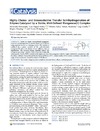Please use this identifier to cite or link to this item:
https://accedacris.ulpgc.es/jspui/handle/10553/74774
| DC Field | Value | Language |
|---|---|---|
| dc.contributor.author | Brzozowska, Aleksandra | en_US |
| dc.contributor.author | Azofra Mesa, Luis Miguel | en_US |
| dc.contributor.author | Zubar, Viktoriia | en_US |
| dc.contributor.author | Atodiresei, Iuliana | en_US |
| dc.contributor.author | Cavallo, Luigi | en_US |
| dc.contributor.author | Rueping, Magnus | en_US |
| dc.contributor.author | El-Sepelgy, Osama | en_US |
| dc.date.accessioned | 2020-10-15T12:22:54Z | - |
| dc.date.available | 2020-10-15T12:22:54Z | - |
| dc.date.issued | 2018 | en_US |
| dc.identifier.issn | 2155-5435 | en_US |
| dc.identifier.uri | https://accedacris.ulpgc.es/handle/10553/74774 | - |
| dc.description.abstract | Herein we report unprecedented manganese-catalyzed semihydrogenation of internal alkynes to (Z)-alkenes using ammonia borane as a hydrogen donor. The reaction is catalyzed by a pincer complex of the earth-abundant manganese(II) salt in the absence of any additives, base, or superhydride. The ammonia borane smoothly reduces the manganese precatalyst [Mn(II)–PNP][Cl]2 to the catalytically active species [Mn(I)–PNP]–hydride in the triplet spin state. This manganese hydride is highly stabilized by complexation with the alkyne substrate. Computational density functional theory (DFT) analysis studies of the reaction mechanism rationalize the origin of stereoselectivity toward formation of (Z)-alkenes. | en_US |
| dc.language | eng | en_US |
| dc.relation.ispartof | ACS Catalysis | en_US |
| dc.source | ACS Catalysis [ISSN 2155-5435], v. 8, 5, p. 4103-4109 | en_US |
| dc.subject | 221001 Catálisis | en_US |
| dc.title | Highly Chemo- and Stereoselective Transfer Semihydrogenation of Alkynes Catalyzed by a Stable, Well-Defined Manganese(II) Complex | en_US |
| dc.type | info:eu-repo/semantics/article | en_US |
| dc.type | Article | en_US |
| dc.identifier.doi | 10.1021/acscatal.8b00983 | en_US |
| dc.description.lastpage | 4109 | en_US |
| dc.identifier.issue | 5 | - |
| dc.description.firstpage | 4103 | en_US |
| dc.relation.volume | 8 | en_US |
| dc.type2 | Artículo | en_US |
| dc.description.numberofpages | 7 | en_US |
| dc.utils.revision | Sí | en_US |
| dc.date.coverdate | Marzo 2018 | en_US |
| dc.identifier.ulpgc | No | en_US |
| dc.description.sjr | 4,702 | |
| dc.description.jcr | 12,221 | |
| dc.description.sjrq | Q1 | |
| dc.description.jcrq | Q1 | |
| dc.description.scie | SCIE | |
| item.fulltext | Con texto completo | - |
| item.grantfulltext | open | - |
| crisitem.author.dept | GIR IUNAT: Fotocatálisis y espectroscopía para aplicaciones medioambientales. | - |
| crisitem.author.dept | IU de Estudios Ambientales y Recursos Naturales | - |
| crisitem.author.orcid | 0000-0003-4974-1670 | - |
| crisitem.author.parentorg | IU de Estudios Ambientales y Recursos Naturales | - |
| crisitem.author.fullName | Azofra Mesa, Luis Miguel | - |
| Appears in Collections: | Artículos | |
WEB OF SCIENCETM
Citations
104
checked on Jun 8, 2025
Page view(s)
181
checked on Jul 12, 2025
Download(s)
525
checked on Jul 12, 2025
Google ScholarTM
Check
Altmetric
Share
Export metadata
Items in accedaCRIS are protected by copyright, with all rights reserved, unless otherwise indicated.
